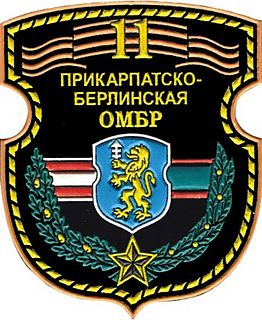The 2nd Red Banner Army was a Soviet field army of World War II that served as part of the Far Eastern Front.

The 34th Tank Division was a formation of the Red Army and Soviet Ground Forces that was formed twice.
A rifle corps was a Soviet corps-level military formation during the mid-twentieth century. Rifle corps were made up of a varying number of rifle divisions, although the allocation of three rifle divisions to a rifle corps was common during the latter part of World War II.
The 8th Estonian Rifle Corps was a formation in the Soviet Army, created on 6 November 1942, during World War II.

The 41st Combined Arms Army is a field army of the Russian Ground Forces, currently part of the Central Military District. Originally, it was formed in 1942 as part of the Soviet Red Army, during World War II. It was reformed in 1998, when the Transbaikal Military District and Siberian Military District were amalgamated.
The 17th Army of the Red Army was a Soviet field army. Formed in 1940, the army served in the Soviet Far East during World War II and fought in the Soviet invasion of Manchuria in August 1945. It was disbanded postwar in mid-1946.
The 10th Rifle Division was a military formation of the Red Army. It existed by 1920, but was formally created on 20 June 1922, based on the 29th Infantry Brigade. It was then recreated at Vladimir in September 1939, and fought in the Second World War.
The 27th Army was a field army of the Soviet Union's Red Army, which fought in World War II.
The 10th Tank Corps was a tank corps of the Red Army, formed twice.
The 2nd Rifle Corps was an infantry corps of the Red Army during the interwar period and World War II, formed twice.

The 11th Guards Mechanized Brigade is a unit of the Armed Forces of Belarus based in Slonim. The 11th Guards Brigade traces its history back to the 1942 formation of the 6th Tank Corps of the Soviet Army during World War II.

The 19th Guards Mechanized Brigade is a formation of the Armed Forces of Belarus based in Zaslonovo (ru:Заслоново), a few kilometers east of Lepiel. The brigade traces its history back to the 1942 formation of the 2nd Guards Mechanized Corps of the Soviet Army during World War II. Subsequent designations during the Cold War included 2nd Guards Mechanized Division and 19th Guards Tank Division. Following the Cold War, the 19th Guards Tank Division was relocated to Belarus and became part of their armed forces in 1992. Thereafter, the unit was reduced to a personnel and equipment cadre unit and titled the 19th Guards Base for Storage of Weapons and Equipment before being upgraded to a mechanized brigade in 2008.
The 25th Army Corps was an army corps of the Soviet Ground Forces active from 1957–1960 and 1980–89. In its first period of existence it was in the Odessa Military District, and in its second period of existence it garrisoned the remote Kamchatka region and Chukotka Autonomous Okrug of the Soviet Far East.
The 61st Army was a field army of the Red Army and the Soviet Ground Forces. It was created in 1941 and disbanded in 1945. It took part in Operation Bagration and the Riga Offensive of 1944.
The 5th Rifle Corps was a corps of the Soviet Union's Red Army, formed twice.
The 17th Rifle Corps was a corps of the Red Army and later the Soviet Army, formed three times.
The 85th Rifle Corps was a rifle corps of the Red Army and later the Soviet Army.
The 86th Rifle Corps was a rifle corps of the Red Army and later the Soviet Army.
The 12th Rifle Corps was an infantry corps of the Red Army during the interwar period and World War II, formed four times.
The 111th Rifle Corps was an infantry corps of the Red Army during World War II.



